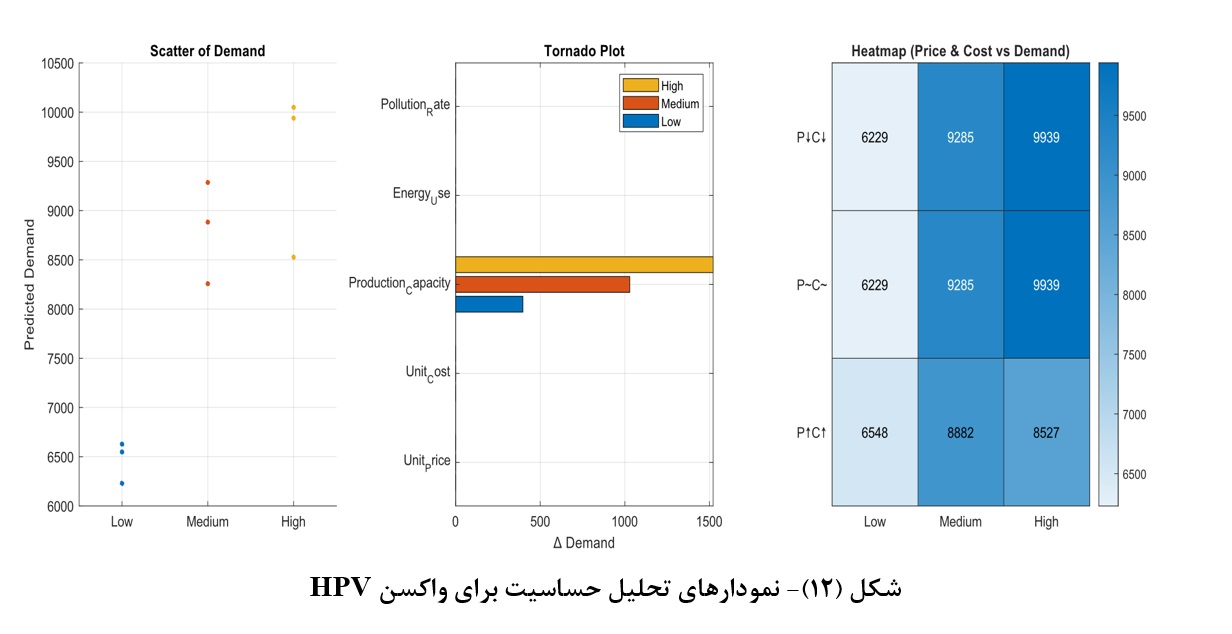مدلسازی ریاضی برنامهریزی تولید دادهمحور با رویکرد چندهدفه و یادگیری ماشین در صنعت زیستدارو: ترکیب پیشبینی تقاضا و بهینهسازی پایدار
کلمات کلیدی:
الگوریتم , LSTM, برنامهریزی تولید دادهمحور, شبکه عصبی مصنوعی, صنعت زیستدارو, مدل چندهدفهچکیده
صنعت زیستدارو بهعنوان یکی از مهمترین بخشهای نوین دارویی، با چالشهای متعددی همچون نوسانات تقاضا، محدودیت منابع، فرآیندهای تولید پیچیده و الزامات زیستمحیطی روبهرو است. در چنین فضایی، رویکردهای دادهمحور و هوشمحور میتوانند نقشی کلیدی در ارتقای دقت تصمیمگیری، پایداری و سودآوری ایفا کنند. پژوهش حاضر با هدف توسعه یک چارچوب جامع برای برنامهریزی تولید پایدار، به ترکیب پیشبینی تقاضا با مدلسازی ریاضی چندهدفه پرداخته است. در گام نخست، دادههای واقعی مربوط به ۹ داروی منتخب طی ۳۶ ماه گردآوری شد و با استفاده از شبکه عصبی مصنوعی (ANN) و حافظه بلندمدت کوتاهمدت (LSTM) الگوهای تقاضا پیشبینی گردید. نتایج نشان داد مدل ANN با خطای RMSE برابر با ۸۶۸ توانست روندهای تقاضا را با دقت متوسط بازسازی کند، در حالیکه مدل LSTM توانست میانگین تقاضا را با خطایی کمتر از یک درصد در سطح دارو–سناریو تخمین بزند. در مرحله دوم، یک مدل ریاضی چندمحصولی و چندهدفه طراحی گردید که اهداف اقتصادی (بیشینهسازی سود و کاهش هزینهها) و زیستمحیطی (کاهش آلایندگی و ضایعات) را بهصورت همزمان در نظر گرفت. برای حل مدل، از الگوریتمهای ژنتیک (GA) و ازدحام ذرات (PSO) به همراه روش اپسیلون–محدودیت برای استخراج جبهه پارتو استفاده شد. یافتهها نشان داد GA در همگرایی سریعتر و PSO در جستجوی گستردهتر فضای جواب برتری نسبی دارند. همچنین تحلیل حساسیت چندمتغیره آشکار ساخت که ظرفیت تولید، هزینه مواد اولیه و نرخ آلایندگی بیشترین تأثیر را بر نتایج دارند. این تحقیق با پر کردن شکاف میان پیشبینی تقاضا و بهینهسازی تولید، چارچوبی عملی برای تصمیمسازی هوشمند در صنعت زیستدارو ایران ارائه میدهد و میتواند به افزایش تابآوری زنجیره تأمین، کاهش هزینهها و تحقق اهداف توسعه پایدار کمک نماید.
مراجع
Ahmed, M. M., et al. (2020). An Environmentally Sustainable Closed-Loop Supply Chain Network. Design under Uncertainty: Application of Optimization..https://doi.org/10.48550/arXiv.2009.11979
Brownlee, J. (2018). Deep Learning for Time Series Forecasting: Predict the Future with MLPs, CNNs and LSTMs in Python. Machine Learning Mastery.
Bertsimas, D., Gupta, V., & Kallus, N. (2018). Data-driven robust optimization. Mathematical Programming, 167(2), 235–292. https://doi.org/10.1007/s10107-017-1125-8
Deb, K., Pratap, A., Agarwal, S., & Meyarivan, T. (2002). A fast and elitist multiobjective genetic algorithm: NSGA-II. IEEE Transactions on Evolutionary Computation, 6(2), 182–197. IEEE. https://doi.org/10.1109/4235.996017.
Daniel Alejandro Rossit, Fernando Tohmé, Mariano Frutos,(2019),A data-driven scheduling approach to smart manufacturing,Journal of Industrial Information Integration,Volume 15,Pages 69-79. https://doi.org/10.1016/j.jii.2019.04.003
Emami H, radfar R, emami F. (2018).Commercialization Modeling and Processes in Pharmaceutical Industry: A Case Study of Presenting an Evaluation Pattern Using Dynamic Programming Model. Hakim; 21 (3):211-220. URL: http://hakim.tums.ac.ir/article-1-1551-en.html
Grand View Research. (2023). Biopharmaceuticals Market Size, Share & Trends Analysis Report. https://www.grandviewresearch.com
Gama, F., Wang, S. (2024). Data-Driven Robust Production Planning. In: Facility Location Under Uncertainty. International Series in Operations Research & Management Science, vol 356. Springer, Cham. https://doi.org/10.1007/978-3-031-55927-3_16
Hu, F., Zhang, L., & Wang, J. (2024). A Hybrid Convolutional–Long Short-Term Memory–Attention Framework for Short-Term Photovoltaic Power Forecasting, Incorporating Data from Neighboring Stations. Applied Sciences, 14(12), 5189. https://doi.org/10.3390/app14125189
Hochreiter, S., & Schmidhuber, J. (1997). Long short-term memory. Neural Computation, 9(8), 1735–1780. https://doi.org/10.1162/neco.1997.9.8.1735
Javaid, W., & Ullah, S. (2025). Data driven simulation based optimization model for job-shop production planning and scheduling: an application in a digital twin shop floor. Journal of Simulation, 1–15. https://doi.org/10.1080/17477778.2025.2469687
Janatyan, N. , Zandieh, M. , Alem Tabriz, A. and Rabieh, M. (2019). Optimizing Sustainable Pharmaceutical Distribution Network Model with Evolutionary Multi-objective Algorithms (Case Study: Darupakhsh Company). Research in Production and Operations Management, 10(1), 133-153.doi: 10.22108/jpom.2019.110116.112
Lee, J. et al. (2015). Recent advances and trends in predictive manufacturing systems in big data environment. Manufacturing Letters, 1(1), 38–41. https://doi.org/10.1016/j.mfglet.2013.09.005
Luo, D., Guan, Z., Ding, L., Fang, W., & Zhu, H. (2025). A Data-Driven Methodology for Hierarchical Production Planning with LSTM-Q Network-Based Demand Forecast. Symmetry, 17(5), 655. https://doi.org/10.3390/sym17050655
Larizadeh, Babak Mohamadpour Tosarkani,(2025).A novel data-driven rolling horizon production planning approach for the plastic industry under the uncertainty of demand and recycling rate,Expert Systems with Applications,Volume 263,ISSN 0957-4174, https://doi.org/10.1016/j.eswa.2024.125728.
Mavrotas, G. (2009). Effective implementation of the ε-constraint method in multi-objective mathematical programming problems. Applied Mathematics and Computation, 213(2), 455–465. https://doi.org/10.1016/j.amc.2009.03.037
Mehrjerdi, Y. Z., & Shafieezadeh, M. (2019). A hybrid PSO for optimization of pharmaceutical product scheduling with environmental considerations. Expert Systems with Applications, 126, 183-195.
MansooriMooseloo, F. , Amiri, M. , Taghavi Fard, M. T. and Hajiaghaei-Keshteli, M. (2024). Designing and planning a bioethanol supply chain network under uncertainty using a data-driven robust optimization model under disjunctive uncertainty sets. Journal of Decisions and Operations Research, 9(2), 327-352. doi: 10.22105/dmor.2024.461901.1849
Ma, S., Zhang, Y., Liu, Y., Yang, H., Lv, J., & Ren, S. (2020). Data-Driven Sustainable Intelligent Manufacturing Based on Demand Response for Energy-Intensive Industries. Journal of Cleaner Production, 274, Article ID: 123155. https://doi.org/10.1016/j.jclepro.2020.123155
Ning, C., & You, F. (2019). Optimization under Uncertainty in the Era of Big Data and Deep Learning. arXiv:1904.01934. https://doi.org/10.1016/j.compchemeng.2019.03.034
Pharmaceutical Technology. (2023). Top 20 biopharmaceutical companies hold their spot despite market cap drop in Q1 2022. Retrieved from https://www.pharmaceutical-technology.com 4. Built In. (2024)
Kabulov, A., et al. (2024). Models, methods and algorithms for monitoring environmental impact on agricultural production. https://doi.org/10.48550/arXiv.2402.03346
Khaled, M. S., Shaban, I. A., Karam, A., Hussain, M., Zahran, I., & Hussein, M. (2022). An Analysis of Research Trends in the Sustainability of Production Planning. Energies, 15(2), 483. https://doi.org/10.3390/en15020483
Kennedy, J., & Eberhart, R. (1995). Particle swarm optimization. Proceedings of ICNN'95 - International Conference on Neural Networks, 4, 1942–1948. IEEE. https://doi.org/10.1109/ICNN.1995.488968
kalantari, M. and Pishvaee, M. S. (2016). A Robust Possibilistic Programming Approach to Drug Supply Chain Master Planning. Journal of Industrial Engineering Research in Production Systems, 4(7), 49-67. doi: 10.22084/ier.2016.1568
Radmehr, M., Abdollahzadeh Sangroudi, H., & Sahebjamnia, N. (2020). An integrated mathematical model of production and distribution planning for radiopharmaceutical products (Case study: Pars isotope company). Supply Chain Management, 22(67), 80-92. DOR:20.1001.1.20089198.1399.22.67.6.5
Sun, D., et al. (2019). PlanningVis: A Visual Analytics Approach to Production Planning in Smart Factories. arXiv:1907.12201. https://doi.org/10.1109/TVCG.2019.2934275
Su, X., Zeng, L., Shao, B. and Lin, B. (2025), "Data-driven optimization for production planning with multiple demand features", Kybernetes, Vol. 54 No. 1, pp. 110-133. https://doi.org/10.1108/K-04-2023-0690
Talagrand, M., Morshedlou, N., & Mansouri, S. A. (2019). A hybrid PSO-based approach for multi-objective production-distribution planning in supply chains. Expert Systems with Applications, 123, 62–78. https://doi.org/10.1016/j.eswa.2019.01.033
Shah, N. (2020). Challenges in Biopharmaceutical Manufacturing. Biotechnology Advances, 39, 107465.
Sachidananda, M., Lienert, T., & Fischer, U. (2016). Discrete event simulation based decision support for dynamic production environments in biopharmaceutical industry. *Procedia CIRP, 49*, 39–44. https://doi.org/10.1016/j.procir.2015.07.026
Yu, Y., Zhang, Y., & Yang, L. (2020). Demand Forecasting in Pharmaceutical Supply Chain: A Hybrid Intelligent Model. Journal of Intelligent Manufacturing, 31(2), 389–404.
Völker and L. Mönch, "Data-Driven Production Planning Models for Wafer Fabs: An Exploratory Study," in IEEE Transactions on Semiconductor Manufacturing, vol. 36, no. 3, pp. 445-457, Aug. 2023, doi: 10.1109/TSM.2023.3277410
Zhang, H., Wang, H., Liu, Y., & Chen, M. (2022). Predicting demand for pharmaceutical time series data using shallow and deep neural networks. Neural Computing and Applications, 34, 11625–11641. https://doi.org/10.1007/s00521-022-07889-9
Zhang, L., Liu, Y., & Zhao, X. (2020). Multivariable sensitivity analysis of biopharmaceutical demand forecasting using artificial neural networks. Journal of Biomedical Informatics, 109, 103526. https://doi.org/10.1016/j.jbi.2020.103526

دانلود
چاپ شده
ارسال
بازنگری
پذیرش
شماره
نوع مقاله
مجوز
حق نشر 2025 سید قاسم سلیمی زاویه, ابوالفضل کزازی , ایمان رئیسی وانانی, سید سروش قاضی نوری (نویسنده)

این پروژه تحت مجوز بین المللی Creative Commons Attribution-NonCommercial 4.0 می باشد.






